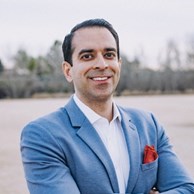Hamed Abbaszadegan, M.D., MBA, a physician executive with PINC AI™ Stanson, outlines how the company works with payers and providers to enhance patient outcomes, minimize costs and meet business goals.

Payer-provider collaboration has become a top priority for 2023. Providers must now work with payers to coordinate care and avoid readmissions as the health care industry transitions to value-based care (VBC) models.
This shift is somewhat challenging due to the long-standing mistrust between payers and providers. Although collaboration isn’t always simple, improving health outcomes while reducing health care costs is a shared objective of payers and providers.
During the recent Payer-Provider Collaboration Virtual Briefing, Hamed Abbaszadegan, M.D., MBA, a physician executive for PINC AI™ Stanson, offered his insights on ways payers and providers can align financial incentives, enhance patient outcomes, close the care continuum gap, and forecast the path to VBC delivery.
The Q&A below has been edited for length and clarity.
What do you see as the biggest barrier to enabling payer-provider collaboration in support of VBC? What is keeping our health care providers and payer executives up at night?
Whether you're on the payer side or the provider side, I believe one of the big issues is not getting the right information to the right person in order to make the best decisions. Executives worry that they are either underpaying or overpaying if they don't have reliable information. Therefore, that consequently has a direct impact on the financial components.
How can technology be used to improve outcomes and capture patient needs?
There's just so much to discuss with technology but the spotlight is on artificial intelligence (AI) and machine learning (ML). Leveraging software to extract and process data and present that data to the people that need it is very important. We use ML every day.
One of my favorite uses of ML is in market basket analysis. For instance, if you search for corn chips on Amazon, you'll see results for corn chips, but you'll also see results for salsa because we typically eat corn chips and salsa together. The machine was able to identify patterns and found people who order corn chips also order salsa. This is not ever going to be known by a machine but seeing patterns in data can help with decision-making.
Technology is used in a similar manner in healthcare. We look at disease processes, coding and prior authorization and gather this information to look for patterns. With ML, we can help providers identify which patients require certain tests and which don’t, as well as assist providers with coding based on the information already present in the chart. We can even generate predictions regarding disease outcomes to help assist providers determine when interventions are needed. As amounts of data increases, the ability to process this and make sense in an actionable manner becomes useful in clinical care.
How do you get clinicians involved in the Hierarchical Condition Category (HCC) coding process?
HCC coding is really all about capturing the complexity of the patient and the clinical care needs that the patient will have. Although it’s a very effective concept, we can't expect clinicians to be master coders.
HCC codes tie directly to ICD-10 codes. However, that in itself is complex. For example, if you search for the top 10 most comical ICD-10 codes, one of them you'll find is V97.33XD, which means “Sucked into jet engine, subsequent encounter.” That's a real code. I didn't make it up. There is a code literally for everything.
Therefore, in order to get clinicians involved in the HCC process, it has to be simplified in the workflow. What PINC AI™ Stanson does well is bring the right information to a clinician, so that when you're inputting in the diagnosis, the appropriate code will prompt the clinician to the fact that ‘Your patient has these different clinical factors and certain lab results, therefore would you like to code at a more specific level based on what is already in the chart?’
An everyday example of this is your map application on your cell phone. You’re generally going to get two to three options on which direction to take. That information delivered to you is decision support. The app is supporting the decision you are going to make about which route to take to your destination. This is the same concept in health care. The PINC AI™ Stanson HCC alerts let the clinician decide on the appropriate clinical complexity as we provide them with the appropriate information at the moment they are working on this task.
What are different things from a data standpoint that payers and providers can do to ease collaboration?
I think the way software is utilized to look for patterns will help everyone out. It's also the key to transforming prior authorization. PINC AI™ Stanson is doing some of that work by automating those medical necessity reviews and getting it done at the point of care to get instant approvals. The only way that can be done is by leveraging technology and the only way everything is going to work seamlessly is if the data is precise and accurate.
I already can hear the naysayers saying, ‘Well, your data is only as good as what's put in.’ It's true, but we also know that a lot of the information in your medical record, such as lab results and medications you take, is real.
It's objective data, so if we can gather it and make decisions that are automated, we won't need to have many people sort through it, look back and re-engage the clinician again when their mind is already off of it. We're going to see a much bigger, more dramatic improvement, speed, and consistency with how these reviews are done.
What are some examples of low-value care and reducing waste in health care?
Examples of low-value care are unnecessary images and unnecessary labs. I can list many family members that have called me with some slight abnormal shadow on some random x-ray. This has then led to follow up with specialists (two to three additional images), and in the end, there was nothing of clinical significance going on. Obviously, that is a good outcome, and we were relieved when it turned out to be nothing. However, we really have to choose wisely as clinicians. This message comes from the American Board of Internal Medicine Foundation. They created this movement of “Choosing Wisely” to promote better patient-physician conversations and bring awareness to unnecessary medical tests and procedures.
So, flipping the script now, how do you leverage those types of evidence-based suggestions from different governance boards around the medical societies into practice? It comes back to what we were saying before—you use intelligent prompts and alerts to provide your clinician with information so they can make decisions.
One good example of this is Vitamin D. It was all the rage not too long ago to get your Vitamin D levels checked. However, it has now fallen out of favor for routine screening. Of course, there are times when you need to check Vitamin D and replace it. But the American Board of Internal Medicine Choosing Wisely Campaign no longer recommends Vitamin D screening for routine testing. So, we must incorporate this constant update of information and changes in guidelines into practice by embedding it into the workflow of our clinicians. As a result, we can continue to help reduce waste and keep care at the highest possible value.
What is one piece of advice you would give to health care organizations?
My biggest advice is to do something. I think it’s important to just take that first step and recognize that this technology has long been present and that there is so much that automation can do for you. Whether you are on the payer side or provider side, we are all going to make better decisions with better real-world data. For example, over the last few years, map applications have only gotten better and more accurate with predicting time to destination. I don't know about you, but I can barely get to my destination faster than the map app’s predicted arrival times, especially compared to five years ago, when I would be minutes ahead of schedule. So, we’ve got to instill that confidence in the healthcare side and once that confidence sets route, we're going to move into a new frontier.
For more on this topic:
Click here to watch the full panel discussion.
Learn about what a partnership with PINC AI™ Stanson can do for your health care organization.
About Hamed Abbaszadegan, M.D., MBA
 Dr. Abbaszadegan is a double board-certified physician in the fields of intern
Dr. Abbaszadegan is a double board-certified physician in the fields of intern al medicine and clinical informatics. He served as a chief health Innovation & informatics officer on the health system domain prior to joining Stanson Health.
al medicine and clinical informatics. He served as a chief health Innovation & informatics officer on the health system domain prior to joining Stanson Health.
His focus throughout his career has remained around informatics and patient safety initiatives stemmed from big data applications for front-line clinical care. Since joining Stanson Health, he has served as one of the physician executives. His work remains rooted in utilization of clinical decision support tools for optimization of health care delivery.
